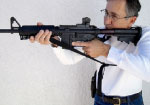One of the most difficult jobs for the law enforcement administrator is the management of tactical resources. Whether the job is a barricaded gunman bent on suicide or a terrorist organization taking hostages in a public building. The law enforcement administrator is faced with the same challenge - how best to deploy his/her resources to facilitate a successful resolution of the problem.
The term "Crisis Management" is a well-used term in law enforcement. It may refer to intervening during a family "crisis" or it may refer to a bank robber caught inside a bank with hostages. Robert Kupperman in his article "The Need For Crisis Management" refers to "Crisis Management"" as any process which a manager exercises to meet his goals within a potentially deteriorating situation at an acceptable cost to him, persuading those with whom he is interacting that the cost of opposing him are greater than the costs of allowing him to attain his objectives. The Federal Bureau of investigations refers to the same process as "Confrontation Management".
Whichever term you choose, for the law  enforcement officer, it means putting your people or yourself at risk to save the life of another individual. It also involves resource allocation, urgency, conflict, and various forms of communications. As we recognize all that is involved in the safe resolution of a crisis, we come to realize that there must be more to managing an incident than the immediate reaction of a fighting force. That force must be an effective fighting force and have as much strength as necessary to convince the opposition that it cannot win. Many different facets of law enforcement must become involved in order to achieve this end. With this in mind "Crisis Management” must be inseparable from crisis preparedness and must consist of concerted efforts to jointly develop tools of communications, management and analysis.
enforcement officer, it means putting your people or yourself at risk to save the life of another individual. It also involves resource allocation, urgency, conflict, and various forms of communications. As we recognize all that is involved in the safe resolution of a crisis, we come to realize that there must be more to managing an incident than the immediate reaction of a fighting force. That force must be an effective fighting force and have as much strength as necessary to convince the opposition that it cannot win. Many different facets of law enforcement must become involved in order to achieve this end. With this in mind "Crisis Management” must be inseparable from crisis preparedness and must consist of concerted efforts to jointly develop tools of communications, management and analysis.
"Crisis Management" is a discipline designed to equip the law enforcement commander with the logical and effective method of preparing and employing his resources in a conflict. It offers him a standardized thought process which he can assimilate the myriad of choices he has in the resolution of a crisis. The system is applicable to most confrontations.
The successful resolution of a confrontation can be divided into a seven phase plan.
- Preplanning
- Incident/confrontation
- Initial Response
- Organization of Resources
- Tactical Response
- Resolution
- Post Operation Considerations
There are no distinct separation points between these phases. Actions by individuals and managers will probably overlap. Some actions will be difficult to classify into one phase or another. The phases are an effort to put into perspective, actions that occur rapidly and in different locations during a confrontation. An understanding of these phases will help the crisis manager put his and the suspect's actions into perspective. Keeping them in perspective will help him respond to them in a more economical way. Economical meaning the cost of time, money and lives.
PHASE I - Preplanning
This phase encompasses all the areas that need to be attended to before a crisis occurs. What is done here is vital. This phase will serve as the building block for all the phases of a coordinated response.
The first major area in this phase is organization. How will your department organize to achieve a safe resolution of a crisis? How ambitious will your Department's response be? These responses will be predicated upon intelligence, budget and manpower. Intelligence should be used to make a conscientious and reliable threat assessment. This assessment should consider all the possible types of incidents your Department must prepare for.
Once decisions have been made and your Department's responses established, working procedures must be written. All persons must understand where they fit in to the ""Crisis Management"" response and how other people fit in. It is extremely important that all persons understand their role so their actions will not conflict with other units. Most agencies establish some form of tactical team, hostage negotiations team, ""Crisis Management"" command team, and administrative committees to oversee all the teams. Working plans need to be established on how your Department will respond to predictable situations, such as hostage takers, barricaded suspects, terrorist takeovers, hijackings, fires, floods, earthquakes, lost children, lost hikers, etc.
The value of these plans lay in all persons responsible for a piece of the plan understanding the plan and their role in it. An essential element in good contingency planning is identification of potential problems or targets. These can be targets such as public buildings, power generating stations, dignitary's homes, high buildings, etc.
After identifying any potential problem, complete intelligence must be acquired on the location. As much information as possible about the physical structure must be recorded. One piece of information may be more important than another. The importance is established on its possible usefulness as an information source during the tactical response and resolution phase of the incident. Human information is also necessary. Who might become hostages? What are their strengths and weaknesses? Do they have any unique medical problems or skills? Who can you contact to open a door or provide information about the building or people?
The more information that the crisis manager has at the outset of an incident the more likely there will be a successful resolution of the incident. There can never be too much information.
Training is essential! Once an organization has been established those people involved need to  practice their trade craft. No matter how ambitious or modest the Department's crisis plan is, success will depend on training. Training must be continuous and intelligently tailored to the needs of the Department. Training should be implemented in all areas of the "Crisis Management" plan. On a regular basis the entire capability of the Department must be tested to ensure success.
practice their trade craft. No matter how ambitious or modest the Department's crisis plan is, success will depend on training. Training must be continuous and intelligently tailored to the needs of the Department. Training should be implemented in all areas of the "Crisis Management" plan. On a regular basis the entire capability of the Department must be tested to ensure success.
Tactical planning needs to be done after full intelligence is gathered on a potential crisis site. It should be as detailed as possible and updated on a regular basis. This allows for the changing environment of the site (1.E. new employees, new buildings, new technology, etc.). As part of tactical planning other areas must be addressed and resolved; command and control, who is in charge and who can make decisions applicable to the resolution phase. Jurisdictional problems will always arise during a crisis. Is it federal, state, county or local responsibility to resolve the incident? If worked out before hand it will prevent the confrontation between agencies when they are there to help resolve the same incident.
The tactical plan should look at other areas that are often times forgotten. These areas are:
1. Communications
2. Chain of command
3. Special logistics (five story ladder, etc.)
4. Command post control
5. Liaison
6. Media coordination





